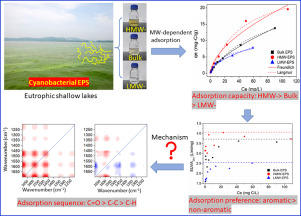当前位置:
X-MOL 学术
›
Sci. Total Environ.
›
论文详情
Our official English website, www.x-mol.net, welcomes your
feedback! (Note: you will need to create a separate account there.)
Adsorption of cyanobacterial extracellular polymeric substance on colloidal particle: Influence of molecular weight.
Science of the Total Environment ( IF 8.2 ) Pub Date : 2020-01-27 , DOI: 10.1016/j.scitotenv.2020.136959 Huacheng Xu 1 , Fangfang Li 2 , Ming Kong 3 , Xizhi Lv 4 , Haiyan Du 1 , Helong Jiang 1
Science of the Total Environment ( IF 8.2 ) Pub Date : 2020-01-27 , DOI: 10.1016/j.scitotenv.2020.136959 Huacheng Xu 1 , Fangfang Li 2 , Ming Kong 3 , Xizhi Lv 4 , Haiyan Du 1 , Helong Jiang 1
Affiliation

|
Cyanobacterial extracellular polymeric substances (EPSs) in aquatic environments are easily adsorbed onto colloidal particles, whereas the adsorption behavior as affected by molecular weight (MW) properties remained unknown till now. Herein, the bulk cyanobacterial EPS matrix (<0.45 μm) was fractionated into high MW (HMW-, 1 kDa~0.45 μm) and low MW (LMW-, <1 kDa) fractions, with MW-dependent adsorption heterogeneities onto TiO2 colloids exploring through batch experiment, UV-Vis and fluorescence spectroscopy, and two dimensional Fourier transform infrared correlation spectroscopy (2D-FTIR-COS). About two-thirds of total organic matters within bulk EPS matrix were distributed in the HMW fraction, leaving one-third in the LMW fraction. Compared to LMW-EPS, the HMW counterpart exhibited higher aromaticity and richness of autochthonous protein-like substances, showing evident MW-dependent differences in abundance and composition. The adsorption capacity based on the measurement of total abundance, UV-Vis and fluorescent spectra all decreased in sequence of HMW- > Bulk > LMW-EPS, demonstrating obvious MW-dependent adsorption heterogeneities. During adsorption, the values of SUVA254 in residual supernatants exhibited an initial decrease followed by gradual increase for all samples, suggesting that the preferentially adsorbed aromatic substances can be subsequently replaced by the non-aromatic moieties. 2D-FTIR-COS further revealed that the carboxylic groups of proteins were preferentially adsorbed onto colloidal surface, followed by the CC functional groups and then the CH groups of polysaccharides, which accounted for the variations of SUVA254 values in the supernatants. This study demonstrated that the adsorption behavior of EPS matrix was highly MW-dependent, and detailed characterization on size fractionation is thus needed in future studies.
中文翻译:

蓝细菌胞外聚合物在胶体颗粒上的吸附:分子量的影响。
在水生环境中,蓝藻细胞外聚合物质(EPSs)容易吸附到胶体颗粒上,而迄今为止,受分子量(MW)性能影响的吸附行为仍然未知。在此,将大部分蓝细菌EPS基质(<0.45μm)分为高MW(HMW-,1 kDa〜0.45μm)和低MW(LMW-,<1 kDa)馏分,并在TiO2胶体上探索了MW依赖的吸附异质性通过分批实验,UV-Vis和荧光光谱以及二维傅立叶变换红外相关光谱(2D-FTIR-COS)。散装EPS基质中大约三分之二的有机物分布在HMW组分中,而三分之一则分布在LMW组分中。与LMW-EPS相比,HMW对应物表现出更高的芳香性和相似度的本地蛋白质蛋白物质,表现出明显的MW依赖性的丰度和组成差异。基于总丰度,UV-Vis和荧光光谱的测量,其吸附能力均以HMW-> Bulk> LMW-EPS的顺序降低,显示出明显的MW依赖性吸附异质性。在吸附过程中,所有样品的残留上清液中SUVA254的值均显示出初始降低,然后逐渐升高的趋势,这表明优先吸附的芳香族物质随后可以被非芳香族部分取代。2D-FTIR-COS进一步揭示了蛋白质的羧基优先吸附在胶体表面,其次是多糖的CC官能团,然后是CH的基团,这是上清液中SUVA254值变化的原因。这项研究表明EPS基质的吸附行为高度依赖于MW,因此在未来的研究中需要对粒度分级进行详细的表征。
更新日期:2020-01-27
中文翻译:

蓝细菌胞外聚合物在胶体颗粒上的吸附:分子量的影响。
在水生环境中,蓝藻细胞外聚合物质(EPSs)容易吸附到胶体颗粒上,而迄今为止,受分子量(MW)性能影响的吸附行为仍然未知。在此,将大部分蓝细菌EPS基质(<0.45μm)分为高MW(HMW-,1 kDa〜0.45μm)和低MW(LMW-,<1 kDa)馏分,并在TiO2胶体上探索了MW依赖的吸附异质性通过分批实验,UV-Vis和荧光光谱以及二维傅立叶变换红外相关光谱(2D-FTIR-COS)。散装EPS基质中大约三分之二的有机物分布在HMW组分中,而三分之一则分布在LMW组分中。与LMW-EPS相比,HMW对应物表现出更高的芳香性和相似度的本地蛋白质蛋白物质,表现出明显的MW依赖性的丰度和组成差异。基于总丰度,UV-Vis和荧光光谱的测量,其吸附能力均以HMW-> Bulk> LMW-EPS的顺序降低,显示出明显的MW依赖性吸附异质性。在吸附过程中,所有样品的残留上清液中SUVA254的值均显示出初始降低,然后逐渐升高的趋势,这表明优先吸附的芳香族物质随后可以被非芳香族部分取代。2D-FTIR-COS进一步揭示了蛋白质的羧基优先吸附在胶体表面,其次是多糖的CC官能团,然后是CH的基团,这是上清液中SUVA254值变化的原因。这项研究表明EPS基质的吸附行为高度依赖于MW,因此在未来的研究中需要对粒度分级进行详细的表征。









































 京公网安备 11010802027423号
京公网安备 11010802027423号